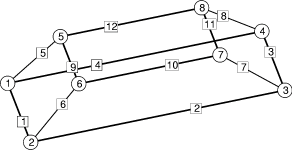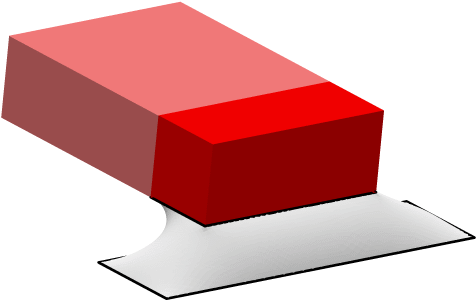

[Click for the tomb-B.fe datafile in a second window.]
This datafile adds a solder blob to the chip-pad model of tomb-A.fe.
 |
 |
| Starting geometry. | Labelling of the vertices and edges of the liquid solder. |
 |
| Evolved shape with 8236 facets. |
set facet tension 300 where not fixed".
read section of the datafile starts off with hessian_normal
so the hessian command considers only motion perpendicular to the
surface, which makes for much easier convergence. It does not converge to
the absolutely best vertex positions for the triangulation, so g
commands can still decrease energy, since g is not restricted
to normal motions. The difference in energy, though, is probably much
less than the imprecision due to the finite triangulation.
target_tolerance is set to 1e-14. This is the criterion for
convergence to the target volume of the solder. The default value of
1e-4 is much too small, since the volume is 2e-8. This is one of the
adjustments that has to be made for doing a physically small model.
gogo for a typical short evolution. It starts out by
refining some longer edges of the solder; the cutoff length of .0048
was chosen to get the desired edges refined. After that, it's just
a little evolution at each refinement, just to set up the hessian
commands for final convergence.
hessian command in gogo causes a conversion from the
Evolver's original style of energy calculation to the newer, more
systematic, named methods and named quantities style. Many energies
have Hessian calculations only in named quantities mode, in this case
gravitational energy. This is not
the default mode yet, since it is a little slower for regular iteration.
(The automatic conversion is new in version 2.11; it may be turned off
by starting Evolver with the -a- option.)
gofar command evolves to a higher refinement, which was used
to make the evolved image on this page.
change_x0, change_y0, and change_z0 for
smoothly changing the position of the chip. Simply changing the
position parameters and relying on the constraints can do some
ugly things to vertices in the middle of chip faces. Also, these
commands linearly interpolate the motion of the liquid solder surface
between the pad and the chip, giving smoother motions over large
distances.
calc_xf, calc_yf, and calc_zf to calculate
the forces exerted on the chip by the surface tension of the solder.
The method is to use the principle of virtual work, moving the
chip a bit (using the change position commands) and finding the
energy difference. Central differences are used for greater accuracy.
script command defined that evolves
and prints energies and z forces to a file called "tomb-b.out".
| Refinement | Solder facets | Energy | Z force |
| 0 | 20 | 0.01380870549 | -5.331341239 |
| 1 | 80 | 0.01285240203 | -1.486858656 |
| 2 | 320 | 0.01262314047 | -1.331459046 |
| 3 | 1280 | 0.01256553334 | -1.376219965 |
| 4 | 5120 | 0.0125521508 | -1.387712914 |
| 5 | 20480 | 0.01254865829 | -1.386935502 |